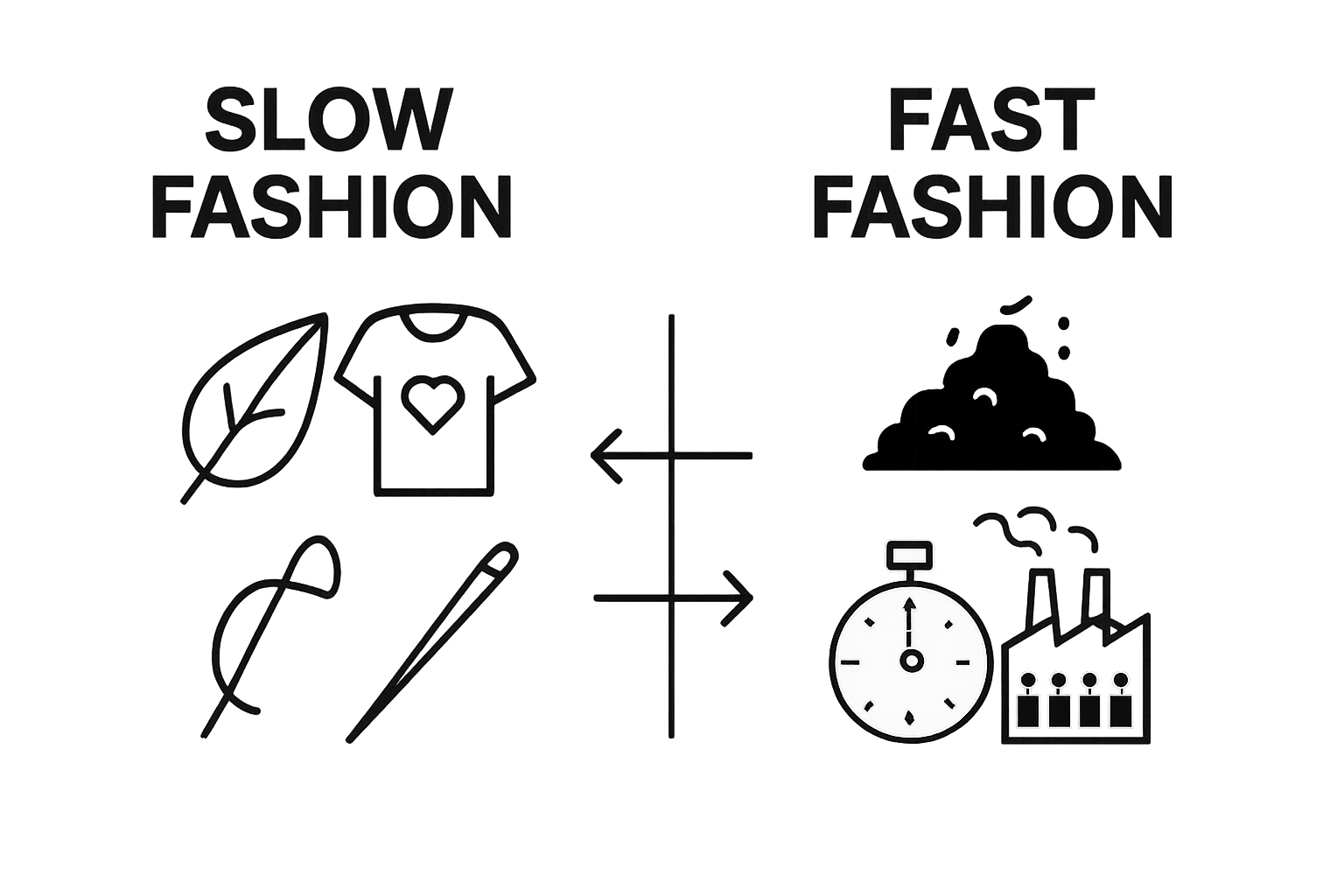What is Slow Fashion? Understanding Its Meaning and Impact
What is Slow Fashion? Understanding Its Meaning and Impact

Slow fashion sounds like a niche trend but it is reshaping how we think about clothing every day. Here is a shocker. The fashion industry is responsible for about 10 percent of global carbon emissions, more than all international flights and shipping combined. You might assume that style always comes at an environmental price yet slow fashion proves that making mindful wardrobe choices can actually help restore the planet and support workers behind every garment.
Table of Contents
- Understanding The Concept Of Slow Fashion
- The Importance Of Sustainability In Fashion
- How Slow Fashion Works: Principles And Practices
- Key Benefits Of Embracing Slow Fashion
- Slow Fashion Vs. Fast Fashion: A Comparative Insight
Quick Summary
| Takeaway | Explanation |
|---|---|
| Prioritize quality over quantity in fashion. | Choose durable, high-quality garments over numerous disposable items to support sustainability. |
| Embrace mindful consumption habits. | Engage with your wardrobe by making intentional purchases that align with your values and reduce waste. |
| Support ethical and local production. | Opt for brands that prioritize fair labor practices and local craftsmanship to empower communities and reduce harm. |
| Understand the environmental impact of fashion. | Recognize that clothing production contributes significantly to carbon emissions and waste; choose eco-friendly options. |
| Re-envision clothing as investment pieces. | Shift your mindset to view clothing as long-term investments that reflect your style and values, not just temporary fads. |
Understanding the Concept of Slow Fashion
Slow fashion emerges as a transformative approach challenging the traditional fast fashion model, prioritizing sustainability, ethical production, and mindful consumption. Unlike the rapid, disposable clothing culture prevalent today, slow fashion represents a comprehensive philosophy that reimagines how we design, produce, purchase, and interact with clothing.
The Core Philosophy of Slow Fashion
At its essence, slow fashion is about quality over quantity. According to research in the International Journal of Consumer Studies, this movement shifts consumer mindsets from purchasing numerous cheap items to investing in fewer, more durable pieces. The approach encompasses several critical dimensions:
- Prioritizing sustainable materials and production methods
- Supporting fair labor practices and worker conditions
- Creating clothing designed to last multiple seasons
- Reducing environmental impact through conscious manufacturing
The concept extends beyond environmental considerations. Slow fashion recognizes clothing as more than just a commodity - it represents cultural expression, craftsmanship, and human connection. Designers and brands embracing this philosophy seek to create garments with meaningful stories, transparent supply chains, and minimal ecological footprint.
Principles of Sustainable Design and Consumption
Slow fashion integrates multiple principles that challenge conventional fashion industry practices. Sustainability research identifies five key dimensions that define this approach:
- Equity: Ensuring fair treatment and compensation for workers throughout the production process
- Authenticity: Creating clothing with genuine cultural and artisanal value
- Functionality: Designing versatile pieces that serve multiple purposes and remain stylish across different contexts
- Localism: Supporting regional production and traditional craftsmanship
- Exclusivity: Valuing unique, well-crafted items over mass-produced alternatives
By reimagining fashion as a holistic ecosystem rather than a rapid consumption cycle, slow fashion offers a compelling alternative to the wasteful practices dominating contemporary clothing production.
The table below summarizes key principles that define slow fashion, providing a quick reference for understanding its foundational concepts and goals.
| Principle | Description |
|---|---|
| Equity | Fair treatment and compensation for workers throughout the supply chain |
| Authenticity | Genuine cultural value and artisanal craftsmanship in clothing design |
| Functionality | Versatile, practical designs intended for multiple uses and long-term wear |
| Localism | Support for regional production, traditional techniques, and local artisans |
| Exclusivity | Emphasis on unique, well-crafted items rather than mass-market productions |
It invites consumers to view their wardrobe as a curated collection of meaningful, high-quality pieces that reflect personal values and respect both human and environmental resources.
The Importance of Sustainability in Fashion
Sustainability in fashion represents a critical paradigm shift that addresses the profound environmental and social challenges created by traditional textile and clothing production. The fashion industry has long been recognized as one of the most significant global contributors to environmental degradation, making sustainable practices not just desirable, but increasingly necessary.
Environmental Impact of Fashion Production
The textile industry generates massive ecological consequences that extend far beyond simple material consumption. Clothing production accounts for approximately 10% of global carbon emissions, surpassing international flights and maritime shipping combined. Water pollution, chemical contamination, and massive textile waste represent additional critical environmental challenges that sustainable fashion seeks to mitigate.
Research from Sustainability Sciences reveals that sustainable fashion attributes directly influence consumer perceptions and purchasing behaviors. Key environmental considerations include:
- Reducing carbon footprint through responsible manufacturing
- Minimizing water consumption during textile production
- Eliminating toxic chemical usage in fabric processing
- Promoting biodegradable and recycled material usage
- Implementing circular economy principles in clothing design
Social and Economic Dimensions of Sustainability
Sustainability in fashion transcends environmental concerns, encompassing critical social and economic dimensions. The movement champions ethical labor practices, ensuring fair compensation, safe working conditions, and fundamental human rights for workers throughout the global supply chain. By prioritizing transparency and accountability, sustainable fashion challenges the exploitative practices prevalent in fast fashion manufacturing.
Consumer research indicates that sustainability is increasingly becoming a significant purchase driver. Individuals are more likely to invest in brands that demonstrate genuine commitment to ecological and social responsibility.
 This shift represents not just an environmental imperative, but a fundamental reimagining of fashion’s role in society - transforming clothing from a disposable commodity to a meaningful expression of personal values and collective responsibility.
This shift represents not just an environmental imperative, but a fundamental reimagining of fashion’s role in society - transforming clothing from a disposable commodity to a meaningful expression of personal values and collective responsibility.
How Slow Fashion Works: Principles and Practices
Slow fashion operates as a comprehensive approach to clothing production and consumption that fundamentally challenges traditional fast fashion models. By reimagining design, manufacturing, and consumer engagement, this movement creates a more sustainable and ethical framework for the textile industry.
Design and Production Principles
Intentional design stands at the core of slow fashion practices. Designers focus on creating timeless, versatile pieces that transcend seasonal trends, emphasizing durability, quality, and aesthetic longevity. Research exploring consumer awareness reveals that this approach requires a radical departure from rapid trend cycles.
Key production principles include:
- Utilizing high-quality, sustainable materials
- Implementing small-batch manufacturing
- Prioritizing craftsmanship over mass production
- Minimizing waste through precise cutting techniques
- Selecting materials with minimal environmental impact
Manufacturers embracing slow fashion commit to transparent supply chains, ensuring each garment’s production respects both environmental sustainability and human labor rights. This approach transforms clothing from disposable commodities to meaningful, long-lasting investments.
Consumer Engagement and Mindful Consumption
Slow fashion fundamentally reimagines the relationship between consumers and clothing. Instead of viewing garments as quickly replaceable items, individuals are encouraged to develop deeper connections with their wardrobes. Mindful consumption becomes a critical practice, involving:
- Purchasing fewer, higher-quality pieces
- Understanding garment production histories
- Valuing repair and maintenance
- Supporting local and ethical brands
- Developing personal style beyond temporary trends
This approach challenges consumers to view clothing as an investment, prioritizing quality, versatility, and personal expression over constant wardrobe renewal. By making intentional purchasing decisions, individuals become active participants in promoting sustainable fashion ecosystems, transforming their consumption habits from passive purchasing to conscious selection.
Key Benefits of Embracing Slow Fashion
Embracing slow fashion represents a transformative approach that extends far beyond personal wardrobe choices, offering profound benefits for individuals, communities, and the global environment. By shifting from a consumption-driven model to a more intentional and mindful approach, slow fashion creates meaningful positive impacts across multiple dimensions.
Personal and Economic Benefits
Individual empowerment emerges as a primary advantage of slow fashion. Consumers gain greater control over their clothing choices, investing in pieces that genuinely reflect personal style and values. Research on responsible consumption highlights how this approach leads to more thoughtful purchasing decisions.
Key personal benefits include:
- Developing a more curated, versatile wardrobe
- Reducing long-term clothing expenditure
- Creating a unique personal aesthetic
- Increasing clothing durability and longevity
- Minimizing impulse purchasing behaviors
Economically, slow fashion supports local artisans, small-scale manufacturers, and sustainable design practices. By prioritizing quality over quantity, consumers contribute to a more resilient and ethical fashion ecosystem that values craftsmanship and fair labor practices.
Environmental and Social Impact
The environmental benefits of slow fashion are substantial and far-reaching. Sustainable clothing practices dramatically reduce the textile industry’s ecological footprint, addressing critical issues like waste generation, water pollution, and carbon emissions.
Significant environmental advantages include:
- Reducing textile waste in landfills
- Minimizing water consumption in production
- Lowering carbon emissions from manufacturing
- Promoting biodegradable and recycled materials
- Supporting circular economy principles
Moreover, slow fashion champions social responsibility by ensuring fair wages, safe working conditions, and ethical treatment of workers throughout the global supply chain. This approach transforms fashion from a potentially exploitative industry into a force for positive social change, empowering workers and communities while creating more transparent and accountable production systems.
Slow Fashion vs. Fast Fashion: A Comparative Insight
The fashion industry stands at a critical crossroads, with two fundamentally different approaches defining contemporary clothing production: slow fashion and fast fashion. These models represent contrasting philosophies about consumption, production, and the role of clothing in society.
Production and Design Philosophies
Fast fashion operates on a rapid, trend-driven model that prioritizes volume and speed. Clothing is designed to be quickly produced, cheaply sold, and rapidly discarded. In stark contrast, slow fashion embraces a deliberate, thoughtful approach to design and manufacturing. Research comparing these approaches reveals fundamental differences in their core principles:
Fast Fashion Characteristics:
- Extremely low-cost production
- Weekly trend cycles
- Disposable clothing mentality
- Mass manufacturing in large quantities
- Minimal consideration of environmental impact
Slow Fashion Characteristics:
- High-quality, durable materials
- Timeless design aesthetics
- Emphasis on craftsmanship
- Small-batch, intentional production
- Comprehensive sustainability considerations
Environmental and Social Consequences
The environmental implications of these two approaches are dramatically different. Fast fashion generates enormous waste, with millions of garments ending up in landfills annually. Textile production for fast fashion contributes significantly to global carbon emissions, water pollution, and resource depletion.
Slow fashion represents a holistic alternative, focusing on:
- Reducing overall textile waste
- Supporting ethical labor practices
- Minimizing environmental degradation
- Creating long-lasting, multipurpose garments
- Promoting responsible consumer behavior
Ultimately, the choice between slow and fast fashion reflects broader values about consumption, sustainability, and personal responsibility.
To help clarify the main differences between slow fashion and fast fashion, the table below compares their core characteristics, values, and impacts.
| Aspect | Slow Fashion | Fast Fashion |
|---|---|---|
| Design Focus | Timeless, versatile, high-quality pieces | Trend-driven, rapidly changing designs |
| Production Scale | Small-batch, intentional | Mass production, high volume |
| Material Choice | Sustainable, durable materials | Cheap, synthetic, often unsustainable |
| Labor Practices | Fair wages, safe conditions | Often exploitative, poor working conditions |
| Environmental Impact | Low waste, minimized emissions | High waste, significant emissions |
| Clothing Lifespan | Long-lasting, encourages repair | Short-lived, disposable mentality |
| Consumer Approach | Mindful, invests in quality | Impulse-driven, quantity over quality |

Elevate Your Special Occasion Look With Purposeful Fashion Choices
Discovering the meaning and impact of slow fashion often leads to a search for high-quality, timeless pieces that will truly last. If you have felt overwhelmed by fast fashion and worried about the environmental and ethical consequences of disposable clothing, you are not alone. The need for beautifully made, durable formal dresses that express your values is clear. Now, you do not have to compromise between looking stunning and making mindful purchasing decisions.

At Dress Me Up NY, you can find elegant evening gowns and occasion dresses that align with the values discussed in slow fashion. Our collections emphasize quality materials, expert tailoring, and thoughtful design so you can invest in dresses meant to be cherished for years. Shop with confidence knowing you are making a positive choice for both your wardrobe and the world. Explore your next special outfit at Dress Me Up NY and enjoy exclusive offers and seamless shopping today.
Frequently Asked Questions
What is the meaning of slow fashion?
Slow fashion is a movement that prioritizes sustainability, ethical production, and mindful consumption, contrasting with the fast fashion model by emphasizing quality, durability, and a deeper connection with clothing.
How does slow fashion impact the environment?
Slow fashion contributes to environmental sustainability by reducing carbon emissions, minimizing textile waste, promoting the use of sustainable materials, and encouraging circular economy principles in clothing design and production.
What are the key principles of slow fashion?
The key principles include equity in labor practices, authenticity in craftsmanship, functionality in design, local production support, and exclusivity through unique, well-crafted items.
How can consumers participate in the slow fashion movement?
Consumers can participate by choosing to buy fewer, high-quality pieces, supporting local and ethical brands, valuing garment repair, and developing a personal style that transcends temporary trends.
Recommended
- Terani Couture 251P4397 Scoop Neck Strapless Long Dress
- Terani Couture 1811GL6436 Deep V-neck Long-sleeve Dress
- Clarisse 810413 Plunging V-neck Sequin Stretchy Prom Dress

